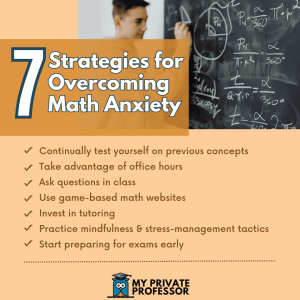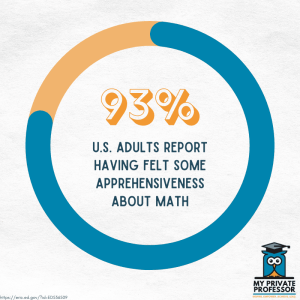By Sophia Manodori, MPP Tutor
My name is Sophia Manodori, and I’m a math and data science double major at Smith College. I do research in theoretical machine learning and artificial neural networks, and work as a discrete mathematics teaching assistant and quantitative learning tutor on campus. I also work as a math tutor for My Private Professor. And up until 12th grade, I hated math.
It’s not just that I didn’t like math. I truly, deeply hated it. I thought it was useless, boring, and stressful.
It all started in elementary school, when I attended a public school in San Francisco. I was bored out of my mind in math class. I never felt that math challenged me. My only real interactions with it were repetitive worksheets. I didn’t understand why math mattered in the world. So I came to the conclusion that it was lifeless and uninteresting. 
In middle school, I was homeschooled, and enrolled in rigorous online algebra classes that moved so fast I could barely keep up. The teachers would only explain the problems in one specific way, which I didn’t understand. In these classes, I constantly felt overwhelmed and stressed, and began to hate math simply because I couldn’t understand it.
In high school, I attended a private boarding school. Again, I found myself bored in math. So I decided to enroll in a more rigorous online calculus course for credit. To reduce my stress around this class and better understand the material, I met with a tutor every week.
This tutor changed the way I saw math.
My tutor explained math as a puzzle that I needed to solve. We stopped when I didn’t understand something, but we never spent too much time on areas in which I was confident. In those sessions, I began to discover that I do, in fact, really like solving math problems. I just didn’t like the previous teaching methods I had become accustomed to.
Of course, I don’t like solving trivial worksheets. And I don’t like lagging behind in a course where I don’t understand anything. But I love solving challenging problems when I’m given the opportunity to work in my own way, at my own pace.
Math is a widely disliked subject. If I tell people I’m a math major, most give me a mildly disgusted look.
A research study by Princeton’s educational testing service found that, among elementary and secondary students, math was the most hated and most boring subject.
A Pew Research Study found that over half of American adults think that the primary reason why students choose STEM degrees less often than other fields is because STEM subjects are too difficult to learn.
Why do we have these feelings about math?
These sentiments are ultimately symptomatic of an unevolved education model that treats all students as though they learn in the same ways.
Math is a unique subject, because it’s the pursuit of ultimate truth. Whether you’re dealing with fractions, word problems, or geometry, you can pretty much expect one thing to be true:
You have a problem, and there is (usually) only one provable, true solution. This is a terrifying notion for students—it means that there is an infinite number of wrong answers.
To teach math, it’s necessary to alleviate the fear of getting the wrong answer so that students can feel safe exploring the subject. When teachers grade a problem solely based on the final product, they consequently instill a fear in students that, regardless of their work quality, their final answer carries all the worth.
Problems with the current models
What’s worse is that in most cases, students are taught to solve these problems using definitive, step-by-step instructions with little to no explanation for why they’re going through these steps. This makes it a game of memorization, as opposed to one of critical thinking. If a student gets a wrong answer, they don’t know why it’s wrong. This turns math into a perilous, no-man’s-land, where every unknown misstep triggers the fear of the big red “wrong” or “incomplete” plastered onto students’ hard work.
In addition, this one-size-fits-all approach assumes that all students think of numbers in the same way, which is false. The ways that students think about fundamental operations (like subtraction and addition) can vary widely. And yet, educators often teach math operations in a single, step-by-step way. 
How can we expect students to find joy in math if we never explain them the underlying reason for the techniques they learn? How can we expect students to find joy in math when they are so afraid of getting the wrong answer that they don’t want to explore new techniques and methods?
Even the common core, or so-called “new math” curriculum, makes the mistake of expecting a set of step-by-step justifications for math problems, neglecting to consider that a student’s process will vary depending on how they think about mathematical operations.
How we teach math needs to change.
Students should be graded on not only the answer, but also on the process they used to get there. And teachers should explain the underlying reasons behind techniques.
They should frame math not as a solely theoretical subject, but as a language in which we can understand the world. We need to show students the incredible scope of mathematics in our world. Yes, we use math to count money and various objects. But plants also use it to optimize sun exposure. Computers use it to mimic human brain cells. The government uses it to encrypt messages of national security. And human rights activists use it to monitor data. Students may not have a passion for financial arithmetic, but they may be excited about the presence of the golden ratio in nature.
And lastly, schools should embrace the fact that students are individual. They need to think about math in their own ways. Students need individual attention to discover the optimal ways to think about math for their unique brains. And that’s why tutoring is so important.
Tutoring helps students develop a deeper, more personal understanding of the ways that numbers interact. And tutoring can help students shift their perception of math—from a problem to a challenging puzzle. This type of thinking prevents math from being a detestable subject—and instead, promotes understanding it as a tool we can use for wonder, discovery and growth.








